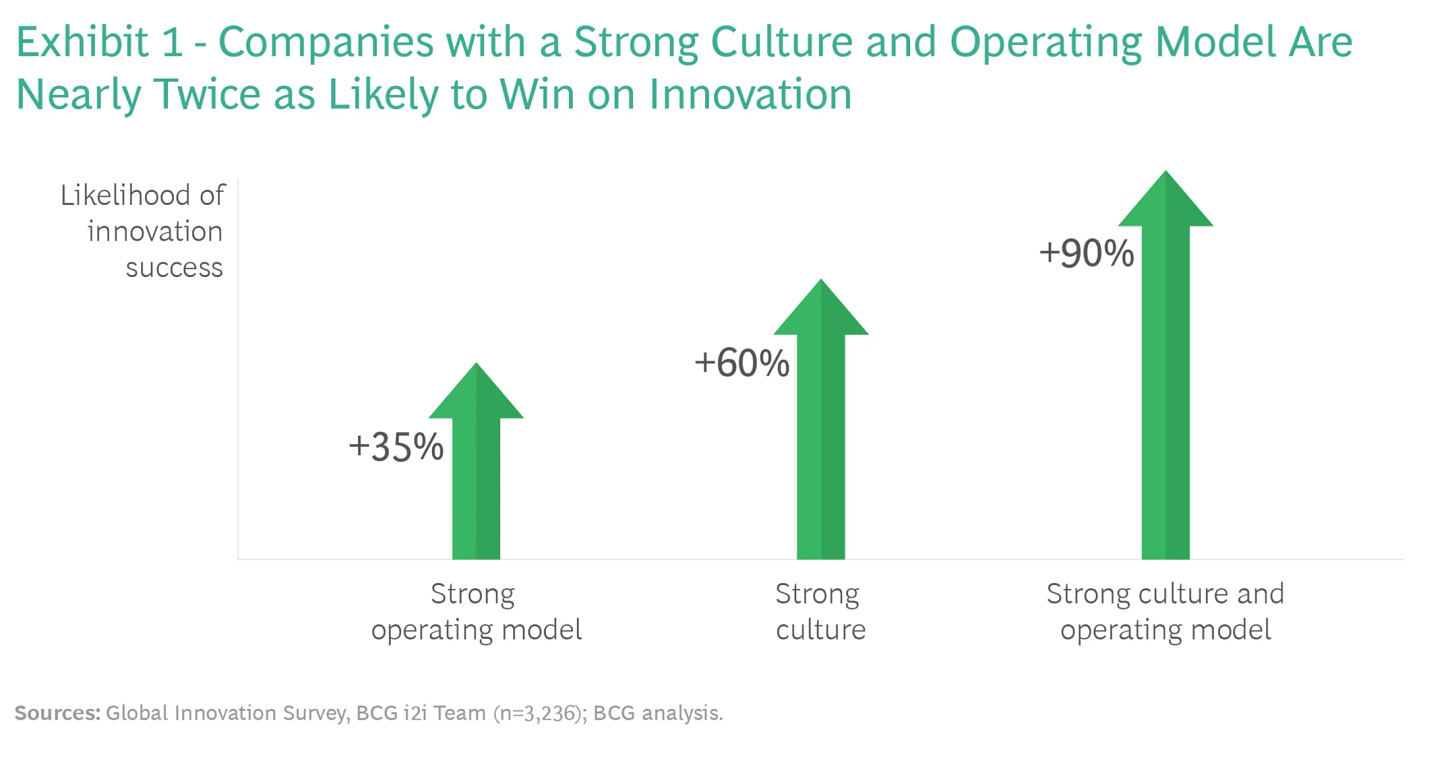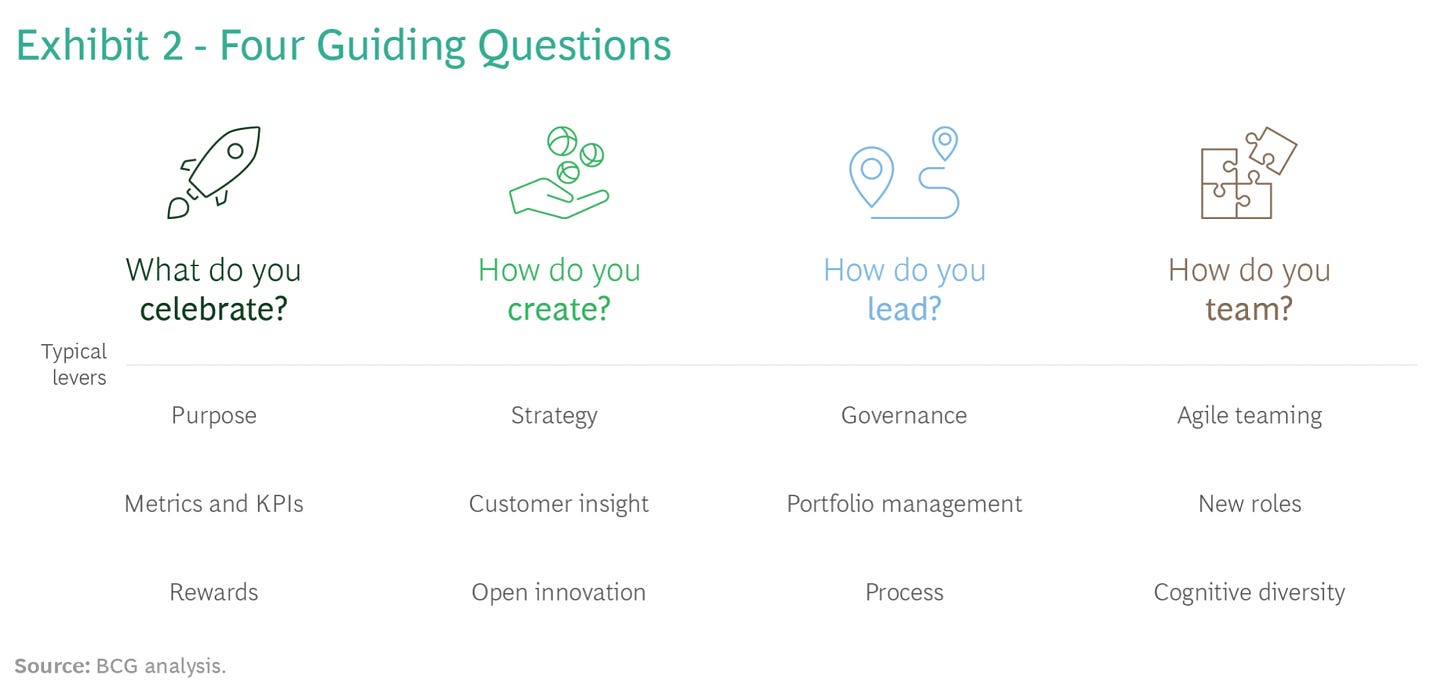BCG: An Innovation Culture That Gets Results
Featured article for this week's Brief
Read time: 3 min
Photo by Skye Studios on Unsplash
Big Idea
Companies should increase investment in innovation even during volatile times, as those with strong innovation cultures that embrace risk, collaboration, and autonomy tend to significantly outperform peers. Building an innovation culture requires clearly articulating desired behaviors, activating them through leaders who role model them, and structurally embedding them into the operating model.
Top Thoughts
Companies with strong innovation cultures that foster creativity, idea-sharing and smart risk-taking are 60% more likely to be innovation leaders able to thrive during uncertainty.
Organizations that couple a vibrant innovation culture with governance mechanisms and operating structures are nearly twice as likely to achieve world-class innovation outcomes that drive growth.
Leaders should examine what successes they reward, how ideas are created, what decision rights people have, and how inclusive teams are formed in order to shape the context for innovation.
Quick wins like allowing "magic hours" for passion projects, building external partnerships, and removing communication barriers can spark lasting culture change with tangible impact.
Articulating the specific mindsets and behaviors that unlock innovation provides clarity on expectations and gives employees confidence to take chances without fear of failure.
Senior leaders and managers across the company need to actively role model desired innovation activities rather than just talking about them in order to make them stick.
Hardwiring vital innovation behaviors into formal incentives, talent development, idea sharing forums, and operating procedures embeds them into the organizational DNA.
Tolerating failure while maintaining high standards, and providing creative freedom within principles and structures, strikes the ideal balance for breakthroughs.
Quick Quotes
“From our experience, we’ve identified four aspects of innovation culture on which companies often focus: what successes you celebrate, how you create, how you lead, and how you team. Importantly, these aspects either add—or destroy—value, depending on how your teams work together.”
"Our research and survey results consistently show that companies with an innovation culture—those that embrace risk, foster collaboration, and grant autonomy to their teams—are 60% more likely to be innovation leaders."
"Companies with strong innovation cultures are 60% more likely to be innovators, while those with strong mechanisms in place (the hardware) are 35% more likely to be innovators. Those with both—we call them innovation culture leaders—are nearly twice as likely to be a world class innovator."
"To innovate, employees need time and space to think beyond their current tasks. Another is the lack of a central hub where employees can share knowledge and jointly develop ideas. Performance management systems that do not recognize initiative, knowledge sharing, and achievements are a third obstacle."
"Unilever augmented its in-house expertise with research contracts and joint initiatives with other local universities for more transactional work and new technologies such as high-throughput robotics and digital modeling capabilities. In this way, it expanded its access to talent while reducing its cost base."
"By empowering teams to pursue projects that have significant commercial potential, companies can de-risk the crucial early stages of innovation. It took many months for EDP to strike the right balance between empowering the teams while providing them with direction."
“At Rakuten’s corporate office today, there are employees who have migrated from Bulgaria, France, Indonesia, Germany, Iran, and elsewhere, and 80% of its new engineers hail from countries other than Japan—a total of 70 different nations in all."
"Leaders articulate an innovation vision for their company and personally engage in key ecosystem outreach activities. They inspire innovation by providing the needed hardware to support the software: the incentives, platforms, and mechanisms for celebrating, cultivating, and rewarding new ideas."
"Innovation leaders “have a tolerance for failure—but an intolerance for incompetence.” Innovation requires freedom to flourish, but boundaries and conditions in order to thrive. That’s the essence of a high-impact innovation culture."
"By focusing intently on these three areas—articulating, activating, and embedding the right behaviors—you’ll be able to establish the best possible conditions for creating, teaming, leading, and celebrating innovation."
Actionable Advice
Give employees time for "magic hours" to work on side projects and innovations.
Build an open innovation ecosystem with external partners.
Empower teams to pursue ideas with significant commercial potential.
Remove barriers to communication and collaboration within the company.
Articulate specific behaviors critical for innovation success.
Leaders should role model and support innovation-fostering activities.
Embed desired behaviors into incentives, policies, processes and hiring.
Source(s)
Manly, J., Harnoss, J.D., Schmitt, H.L., Werner, R., Blanchard, D., & Lovich, D. (2023, July 26). An Innovation Culture That Gets Results. [Web Article]. Boston Consulting Group. (Link)






